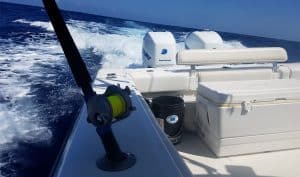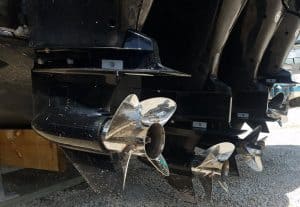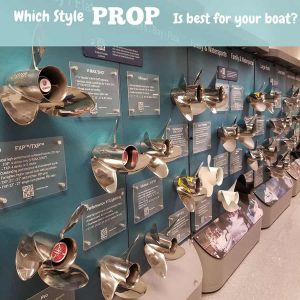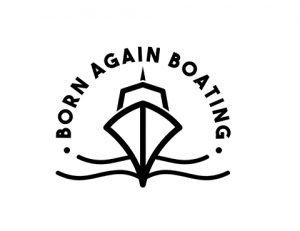Propellers are the wheels of your boat. There are so many different types and styles it’s almost impossible to keep up with them. They are extremely important and will have a massive effect on the way your boat performs. So, what does it mean exactly to prop out a boat?
Propping Out A Boat: What It Is & Why It’s Important! Propping out a boat is the process of figuring out, then selecting what type and size of propeller will be best for your boat. It has a direct effect on the performance of your boat, the longevity of your engine, and your fuel economy.
Here are the most important things that you need to know to make sure that your boat is propped properly and what the process is to prop it properly.
The Process Of Propping
 Propping out a boat is the process of figuring out what is the best prop to use for your boat.
Propping out a boat is the process of figuring out what is the best prop to use for your boat.
This process is not a difficult process, but it is time-consuming. And without a connection to someone with lots of different props or access to propellers.
It could get expensive to play around with. The process of propping out a boat is basically just trying different props and seeing how they perform!
This means we will put a certain size and type of propeller on the boat. Then go out and test run the boat up to wide-open throttle and see what the performance of the boat is.
If everything isn’t inside of the ranges that they need to be. We will have to return to the dock, remove the propeller, install another propeller.
And then go back out for another test run to see the performance.
We’ll continue this process until the correct propeller is found to match the desired performance that you want!
What You Need To Know To Prop The Boat
There are a couple of key features that you will need to know about before beginning this process.
If we are talking about a new boat. We will get a starting propeller size suggestion from the boat manufacturer. One thing that you should decide though, is what you are looking for, performance-wise.
Are you looking for a better hole-shot or are you looking for top-end speed? This will determine the number of blades that you want to have on the propeller.
The main things that you are going to need to know are your engine’s wide-open throttle RPM range. The propeller size, the top-end speed, and the rev-limiter setting for your engine.
What Things You Want To Look For When Propping
 These things are important to know because you want your engine to be able to ride in the correct RPM range. This is vital when it comes to longevity and care of the engine.
These things are important to know because you want your engine to be able to ride in the correct RPM range. This is vital when it comes to longevity and care of the engine.
You want the engine to be able to get up into the top-end range to burn out carbon and get up to operating temperature. Normally most engines are somewhere between 5,000-6,000 RPMs.
This can vary some, say 4,500-5,500 or 5,800-6,400 RPMs. But these are the normal wide-open throttle ranges.
The rev-limiter on the engine is a feature to keep the engine from turning to fast. It regulates the RPMs so if you go to high, it will drop out a cylinder and lower the RPMs.
If the RPM range is 5,000-6,000. Then the rev-limiter setting is probably going to be 6,200 or 6,300. So if you put a small propeller on the engine. The power of the engine will just spin the propeller up to 6,300 RPMs.
But the boat won’t go anywhere because the propeller is too small to grab the water and push the weight of the boat.
This is what makes knowing the size of the propeller so important. And then knowing the top-end speed of the boat each time you try a different prop. Will let you know if you are going backward or forwards.
But more importantly, is the engine getting to the correct RPM range.
The Basics Of A Propeller
A propeller is measured by the number of blades it has. And then by the diameter of it, along with what is called the propeller pitch.
The pitch of a propeller is described as the theoretical distance that a propeller will move through the water in one revolution.
So a 21 pitch prop, will theoretically go 21 inches through the water in one turn. Then a 19 pitch prop will only go 19 inches and so on.
This is called theoretically because it is not exact and that is depending on the RPMs. Spinning the propeller 6,000 RPMs will change that distance!
There is also what is called the cup of the prop. The props cupping has to do with the curvature of the blade that is on the prop. This changes the grip and bite that the prop will have on the water.
Another way to get a propeller to spin up into the RPM ranges though. Is to vent the propeller before the blades.
This is basically done by drilling a hole in the prop before the blade. Or, most props come with a plug and a predrilled hole in the prop. You can simply take the plugs out to get the prop to spin up faster if need be.
Different Kinds Of Props
 There are a ton of different style propellers. From stainless steel to aluminum. From two blades to six blades. Big blades to little blades and all of the different cupping styles in between.
There are a ton of different style propellers. From stainless steel to aluminum. From two blades to six blades. Big blades to little blades and all of the different cupping styles in between.
Some propellers are designed for gripping the water and others are designed for slicing through the water for speed.
A propeller can also have an effect on how loud the shifting is in the boat! From all of the different designs and productions of propellers out there.
It will ultimately depend on what exactly it is that you are looking to get out of your boat.
How you want your boat to perform will determine the style and kind of propeller that you need to run.
What Your Prop Does For Performance
Are you looking to go fast? Then a higher pitch, lower blade count, skinny bladed prop will be better for you.
Do you want a holeshot? Then a larger bladed, four-bladed prop will probably be better suited for you.
Are you looking for fuel economy? Then running a prop designed to perform with better gas mileage like an eco prop will be best.
Figuring out what style of boat you have and what you are wanting to get from the boat. Will determine how you start this propping out process to determine what propeller is going to be best for you and your boat set up!
Here is a video that will explain more about this process!
Check Us Out!
And now that you know how to prop out a boat. As well as what it means to prop out a boat.
Here are some other articles from us that you will find extremely helpful and informational!
Flipping Boats For Profit: How To Make Money & Not Lose It!
How To Get More Hours Out Of Your Outboard With Less Break Downs!
What To Do When Rope or Line Wraps Around Your Propeller
We’d also like to invite you to check us out on Our YouTube Channel! Where we create all kinds of How-To and DIY boating projects to help you learn more and more about your boat and how it works!
